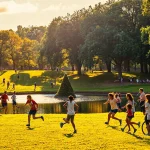Key Unique Challenges Facing UK Athletes in Training
UK athletes face several unique challenges in their training, directly influencing their preparation and competitive edge. One significant barrier is the UK’s often unpredictable weather and climate. Frequent rain and cold conditions can disrupt outdoor sessions, limit consistent practice, and impact performance rhythm. For sports that rely heavily on outdoor environments, this creates an added hurdle compared to athletes training in more temperate climates.
Another pressing issue is the uneven distribution of sports infrastructure and facility availability throughout the UK. Athletes in metropolitan areas may have access to state-of-the-art gyms and specialized training venues, while those in rural or less affluent regions confront limited resources. This disparity creates a training environment gap, affecting skill development and progression opportunities.
Topic to read : How Can UK Sports Transform Local Communities?
Financial support also presents a notable challenge. Many promising athletes experience funding disparities due to the competitive nature of sponsorships and grants. Limited financial backing restricts access to coaching, nutrition, and recovery programs essential for elite performance. Addressing these UK sports training difficulties requires targeted investment and policies to level the playing field for all athletes across the nation.
Effects of Resource Availability and Funding
Understanding the impact on athlete development and performance
Additional reading : What Role Does Technology Play in Enhancing UK Sports Coverage?
Resource availability and funding play a critical role in shaping the athletic landscape across the UK. Sports funding UK is often distributed unevenly, with elite programs receiving priority access to advanced facilities and coaching staff, while grassroots initiatives face frequent resource limitations. This disparity influences the quality of training resources for athletes, affecting skill development and competitive readiness.
National and regional funding structures exacerbate this gap. For example, high-profile sports tend to secure larger shares of government and private investment, enhancing support systems for elite athletes. Conversely, less prominent sports may struggle to fill financial gaps, limiting exposure and growth opportunities. Financial obstacles UK athletes face can include restricted access to specialised equipment, reduced training time due to cost, and fewer chances to compete internationally, all of which hinder progression.
Sponsorship opportunities also vary widely. Athletes in popular sports with significant media coverage often attract substantial endorsements, helping mitigate financial burdens. However, niche sports athletes may find it harder to secure such support, restricting their career sustainability. Awareness of these funding dynamics is crucial for stakeholders working to create more equitable athletic environments.
Access to High-Quality Coaching and Facilities
Understanding the landscape of athletic training in the UK
Geographic disparities in coaching quality UK and sports facilities UK remain significant challenges for athletes nationwide. In many regions, particularly rural areas, access to experienced coaches and modern training centers is limited. This disparity often hinders athlete progress, as the availability of expert guidance and specialized equipment plays a pivotal role in skill development.
The quality of sports facilities UK directly affects not only performance but also injury risk. Facilities lacking appropriate surfaces or outdated training tools can increase the likelihood of physical strain or accidents. Athletes benefit most when training environments meet safety and technological standards, ensuring optimal preparation and reduced setbacks.
To address these issues, several initiatives focus on raising coaching quality UK through certification programs and partnerships between sports bodies and local communities. These efforts emphasize standardized training for coaches, aiming to elevate the overall support system for athletes. Enhanced athletic training support also includes investing in facility upgrades, allowing more equitable access to high-quality environments. Together, these strategies work toward leveling the playing field, helping athletes unlock their potential regardless of location.
Balancing Education, Careers, and Athletic Commitments
Balancing academic or career goals with strenuous training demands is a fundamental obstacle for dual-career athletes UK face daily. These athletes juggle tight schedules that require exceptional time management skills to maintain progress in both their education or professional roles and elite sports performance. The student athlete challenges reverberate strongly around unpredictable competition calendars and training loads, which often clash with study deadlines or work commitments.
In the UK, the framework supporting dual-career athletes incorporates tailored academic flexibility and dedicated mentoring programs. Universities and workplaces frequently collaborate with sporting bodies to develop personalised plans that cater to an athlete’s dual roles. This includes access to specialised tutors, adjusted assessment deadlines, and career counselling focused on sports transitions. Such support systems for dual-career athletes UK are critical, ensuring well-being and sustainable progression in both fields.
Compared to international models, the UK’s approach is nuanced. While many European countries have state-sponsored programs offering financial and logistical assistance, UK structures emphasise personalised support and integration with educational establishments. This approach recognizes individual athlete needs but also depends heavily on proactive communication and institutional flexibility. Through these combined efforts, dual-career athletes can better navigate the complexities of work-life balance UK sport, cultivating success in and out of the sporting arena.
National Sporting Infrastructure and Support Systems
The UK sporting infrastructure forms the backbone for nurturing elite athletes, providing state-of-the-art facilities and comprehensive training centers. These infrastructures are designed to optimize performance and enable athletes to reach their full potential. Key to this framework are the athlete support programs UK, which offer tailored services ranging from medical care to psychological coaching.
Central to success in British sports is the involvement of National Governing Bodies (NGBs). These organizations implement sport-specific strategies aligned with the wider sports policy UK to develop talent pathways effectively. They oversee structured training, competition access, and fundraising, ensuring athletes receive consistent support from grassroots to elite levels.
Additionally, accessibility to performance support services such as nutrition advice, physiotherapy, and biomechanical analysis is crucial. These services enhance athletes’ physical and mental well-being, directly impacting competitive outcomes. Collaboration between government and private sectors further strengthens these systems. This partnership mobilizes resources to maintain funding, upgrade facilities, and foster innovation, all integral components of the UK’s commitment to excellence in sport.
International Comparisons and Athlete Testimonials
Understanding how the UK athlete challenges stack up against global standards provides valuable insight into training dynamics. UK athletes often contend with limited funding and variable weather, impacting outdoor training consistency. In contrast, countries like Australia and Spain benefit from favourable climates that facilitate year-round practice, illustrating a key difference in global sports training comparison.
First-hand UK athlete stories reveal resilience in overcoming infrastructure gaps. Many share experiences of adapting their routines to indoor facilities during harsh winters or seeking innovative cross-training methods. These accounts highlight a persistent determination to excel despite constraints typical in the UK athletic environment.
Learning from international best practices can help address some of these challenges. For example, incorporating sports science advancements common in the US has improved recovery protocols. Similarly, structured talent development programs seen in Scandinavian countries offer models for long-term athlete support.
By comparing diverse training systems and listening to UK athlete testimonials, sports professionals can better adapt strategies. This enhances preparation and performance, bridging gaps between UK circumstances and international standards. Emphasizing such global perspectives encourages the continuous evolution of athlete development pathways.






